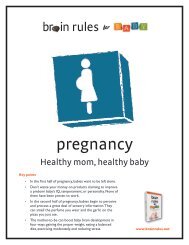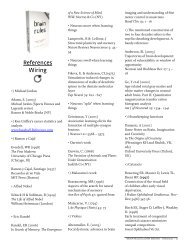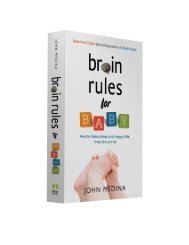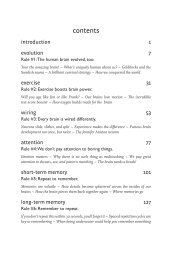Brain Rules Media Kit (PDF)
Brain Rules Media Kit (PDF)
Brain Rules Media Kit (PDF)
- No tags were found...
You also want an ePaper? Increase the reach of your titles
YUMPU automatically turns print PDFs into web optimized ePapers that Google loves.
ABOUT JOHN MEDINAAUTHOR OF BRAIN RULESJOHN KEATLEYDR. JOHN J. MEDINA is a developmental molecularbiologist focused on the genes involved in humanbrain development and the genetics of psychiatricdisorders. He has spent most of his professional life asa private research consultant, working primarily in thebiotechnology and pharmaceutical industries onresearch related to mental health. Medina holds jointaffiliate faculty appointments at Seattle PacificUniversity, where he is the director of the <strong>Brain</strong>Center for Applied Learning Research, and at theUniversity of Washington School of Medicine, in itsDepartment of Bioengineering.Medina was the founding director of the TalarisResearch Institute, a Seattle-based research centeroriginally focused on how infants encode and processinformation at the cognitive, cellular, and molecular levels.In 2004, Medina was appointed to the rank of affiliate scholar at the NationalAcademy of Engineering. He has been named Outstanding Faculty of the Year at theCollege of Engineering at the University of Washington; the Merrill Dow/ContinuingMedical Education National Teacher of the Year; and, twice, the BioengineeringStudent Association Teacher of the Year. Medina has been a consultant to theEducation Commission of the States and a regular speaker on the relationshipbetween neurology and education.Medina’s books include: BRAIN RULES: 12 Principles for Surviving and Thrivingat Work, Home, and School (Pear Press/ Perseus Books Group), The GeneticInferno, The Clock of Ages, Depression, What You Need to Know About Alzheimer’s,The Outer Limits of Life, Uncovering the Mystery of AIDS, and of Serotonin,Dopamine and Antipsychotic Medications. Medina is also the regular “Molecules of theMind” contributing columnist for Psychiatric Times.Medina has a lifelong fascination with how the mind reacts to and organizesinformation. As the father of two boys, he has an interest in how the brain sciencesmight influence the way we teach our children. In addition to his research,consulting, and teaching, Medina speaks often to public officials, business andmedical professionals, school boards, and nonprofit leaders. He lives in Seattle withhis wife and sons.For more information, visit: www.brainrules.net.
ABOUT RICK STEVENSONDIRECTOR OF BRAIN RULES BONUS DVDRICK STEVENSON (Director/ Writer/ Producer) is a Seattle native known forhis work in film and television in the United States, Canada and Great Britain.Stevenson's production credits include PRIVILEGED (1983) starring Hugh Grant;RESTLESS NATIVES (1985) starring Ned Beatty, PROMISED LAND (1987) starringMeg Ryan and Kiefer Sutherland; SOME GIRLS (1989) starring Patrick Dempsey,Jennifer Connelly and Andre Gregory; and CROOKED HEARTS starring JenniferJason-Leigh, Noah Wylie, Juliette Lewis and Peter Coyote. Stevenson made hisfeature film directorial debut in 1995 with MAGIC IN THE WATER, starring MarkHarmon and Joshua Jackson.His next, widely lauded, feature film was THE DINOSAUR HUNTER with ChristopherPlummer (1999). This was followed by ANTHRAX (2001) starring Cameron Daddo,David Keith, William B. Davis, Ed Begley Jr. Most recently, Stevenson directed, cowroteand produced EXPIRATION DATE (2006) starring Robert Guthrie, Dee WallaceStone and David Keith.Stevenson has directed many programs for television including ED for NBC and hiswork as a director of television commercials has garnered a myriad of awards.In 2004, Stevenson founded thefilmschool with Tom Skerritt and Stewart Stern.He holds a PhD from Oxford University, a master's degree from the London School ofEconomics and a bachelor's degree in history from Whitman College in WashingtonState. Rick is married with four children.For more information, visit: www.brainrules.net/film.ABOUT PEAR PRESSPUBLISHER OF BRAIN RULESPEAR PRESS is a small publisher that publishes big books. We plan to publish nomore than one book every year or two because it takes time to deliver qualitycontent.We believe books are still important in the 21st century. We strive to combine thebest of old-world publishing and new-world media. Our mission is to maximize thereach of our content around the world, and so the content takes many forms: printedbook, audio book, documentary film, e-book, video, blog, Web tutorial, e-mailnewsletter or live presentation by one of our authors.Pear Press books are distributed by the Perseus Book Group. For more information,visit: www.pearpress.com.
TALKING POINTS FOR DR. JOHN MEDINAAUTHOR OF BRAIN RULESEXERCISE | Rule #1: Exercise boosts brain power.• There’s a direct link between exercise and brain power. Start exercising couch anddesk potatoes and their brains benefit. Even couch potatoes who fidget show increasedbenefit over those who do not. Our brains perform at their best when we are in motion.• Exercise improves “executive function”: solving problems, maintaining attention, andinhibiting emotional impulses. All it takes for your brain to benefit is aerobic exercise 2-3times a week.• Sitting is not “brain friendly.” For millions of years we walked 12 miles a day. Today wesit in cars, couches, cubicles, and classrooms. We think best when we are moving.• The greatest predictor of successful aging is the presence or absence of asedentary lifestyle. Exercise improves cardiovascular fitness, which reduces the risk fordiseases like heart attacks and stroke. It improves your strength and balance, reduces yourrisk for many types of cancer, bolsters your immune system, and buffers against toxiceffects of stress.• It’s time to integrate exercise into our 8 hours at work or school. Take a call whilewalking, hold a walking meeting, or go for a walk at lunch.SURVIVAL | Rule #2: The human brain evolved, too.• The brain is a survival organ. It is designed to solve problems related to surviving in anunstable outdoor environment and to do so in nearly constant motion (to keep you alive longenough to pass your genes on). We were not the strongest on the planet but we developedthe strongest brains, the key to our survival.• The strongest brains survive, not the strongest bodies. Our ability to solve problems,learn from mistakes, and create alliances with other people helps us survive. We took overthe world by learning to cooperate and forming teams with our neighbors.• Our ability to understand each other is our chief survival tool. Relationships helpedus survive in the jungle and are critical to surviving at work and school today.• If someone does not feel safe with a teacher or boss, he or she may not perform aswell. If a student feels misunderstood because the teacher cannot connect with the way thestudent learns, the student may become isolated.• There is no greater anti-brain environment than the classroom and cubicle.WIRING | Rule #3: Every brain is wired differently.• What YOU do and learn in life physically changes what your brain looks like – itliterally rewires it. We used to think there were just 7 categories of intelligence. Butcategories of intelligence may number more than 7 billion—roughly the population of theworld.• No two people have the same brain, not even twins. Every student’s brain, everyemployee’s brain, every customer’s brain is wired differently.• You can either accede to it or ignore it. The current system of education ignores it byhaving grade structures based on age. Businesses such as Amazon are catching on to masscustomization (the Amazon homepage and the products you see are tailored to your recentpurchases).• Regions of the brain develop at different rates in different people. The brains ofschool children are just as unevenly developed as their bodies. Our school system ignoresthe fact that every brain is wired differently. We wrongly assume every brain is the same.• Most of us have a “Jennifer Aniston” neuron (a neuron lurking in your head that isstimulated only when Jennifer Aniston is in the room).
ATTENTION | Rule #4: We don't pay attention to boring things.• What we pay attention to is profoundly influenced by memory. Our previousexperience predicts where we should pay attention. Culture matters too. Whether in schoolor in business, these differences can greatly effect how an audience perceives a givenpresentation.• We pay attention to things like emotions, threats and sex. Regardless of who you are,the brain pays a great deal of attention to these questions: Can I eat it? Will it eat me? Can Imate with it? Will it mate with me? Have I seen it before?• The brain is not capable of multi-tasking. We can talk and breathe, but when it comes tohigher level tasks, we just can’t do it.• Driving while talking on a cell phone is like driving drunk. The brain is a sequentialprocessor and large fractions of a second are consumed every time the brain switches tasks.This is why cell-phone talkers are a half-second slower to hit the brakes and get in morewrecks.• Workplaces and schools actually encourage this type of multi-tasking. Walk into anyoffice and you’ll see people sending e-mail, answering their phones, Instant Messaging, andon MySpace—all at the same time. Research shows your error rate goes up 50% and it takesyou twice as long to do things.• When you’re always online you’re always distracted. So the always online organizationis the always unproductive organization.SHORT-TERM MEMORY | Rule #5: Repeat to remember.• The human brain can only hold about seven pieces of information for less than 30seconds! Which means, your brain can only handle a 7-digit phone number. If you want toextend the 30 seconds to a few minutes or even an hour or two, you will need to consistentlyre-expose yourself to the information. Memories are so volatile that you have to repeat toremember.• Improve your memory by elaborately encoding it during its initial moments. Many ofus have trouble remembering names. If at a party you need help remembering Mary, it helpsto repeat internally more information about her. “Mary is wearing a blue dress and myfavorite color is blue.” It may seem counterintuitive at first but study after study shows itimproves your memory.• <strong>Brain</strong> <strong>Rules</strong> in the classroom. In partnership with the University of Washington andSeattle Pacific University, Medina tested this <strong>Brain</strong> Rule in real classrooms of 3 rd graders.They were asked to repeat their multiplication tables in the afternoons. The classrooms inthe study did significantly better than the classrooms that did not have the repetition. Ifbrain scientists get together with teachers and do research, we may be able to eliminateneed for homework since learning would take place at school, instead of the home.LONG-TERM MEMORY | Rule #6: Remember to repeat.• It takes years to consolidate a memory. Not minutes, hours, or days but years. Whatyou learn in first grade is not completely formed until your sophomore year in high school.• Medina’s dream school is one that repeats what was learned, not at home, butduring the school day, 90-120 minutes after the initial learning occurred. Ourschools are currently designed so that most real learning has to occur at home.• How do you remember better? Repeated exposure to information / in specifically timedintervals / provides the most powerful way to fix memory into the brain.• Forgetting allows us to prioritize events. But if you want to remember, remember torepeat.
SLEEP | Rule #7: Sleep well, think well.• When we’re asleep, the brain is not resting at all. It is almost unbelievably active! It’spossible that the reason we need to sleep is so that we can learn.• Sleep must be important because we spend 1/3 of our lives doing it! Loss of sleephurts attention, executive function, working memory, mood, quantitative skills, logicalreasoning, and even motor dexterity.• We still don’t know how much we need! It changes with age, gender, pregnancy,puberty, and so much more.• Napping is normal. Ever feel tired at 3PM? That’s because your brain really wants to take anap. There's a battle raging in your head between two armies. Each army is made of legionsof brain cells and biochemicals – one desperately trying to keep you awake, the otherdesperately trying to force you to sleep. At 3PM, 12 hours after the midpoint of your sleep,all your brain wants to do is nap.• Taking a nap at 3PM might make you more productive. In one study, a 26-minute napimproved NASA pilots’ performance by 34 percent.• Don’t schedule important meetings at 3pm. It just doesn’t make sense.STRESS | Rule #8: Stressed brains don't learn the same way.• Your brain is built to deal with stress that lasts about 30 seconds. The brain is notdesigned for long term stress when you feel like you have no control. The saber-toothedtiger ate you or you ran away but it was all over in less than a minute. If you have a badboss, the saber-toothed tiger can be at your door for years, and you begin to deregulate. Ifyou are in a bad marriage, the saber-toothed tiger can be in your bed for years, and thesame thing occurs. You can actually watch the brain shrink.• Stress damages virtually every kind of cognition that exists. It damages memory andexecutive function. It can hurt your motor skills. When you are stressed out over a longperiod of time it disrupts your immune response. You get sicker more often. It disrupts yourability to sleep. You get depressed a lot.• The emotional stability of the home is the single greatest predictor of academicsuccess. If you want your kid to get into Harvard, go home and love your spouse.• You have one brain. The same brain you have at home is the same brain you have at workor school. The stress you are experiencing at home will affect your performance at work, andvice versa.SENSORY INTEGRATION | Rule #9: Stimulate more of the senses.• Our senses work together so it is important to stimulate them! Your head crackleswith the perceptions of the whole world, sight, sound, taste, smell, touch, energetic as a fratparty.• Smell is unusually effective at evoking memory. If you're tested on the details of amovie while the smell of popcorn is wafted into the air, you'll remember 10-50% more.• Smell is really important to business. When you walk into Starbucks, the first thing yousmell is coffee. They have done a number of things over the years to make sure that’s thecase.• The learning link. Those in multisensory environments always do better than those inunisensory environments. They have more recall with better resolution that lasts longer,evident even 20 years later.
VISION | Rule #10: Vision trumps all other senses.• We are incredible at remembering pictures. Hear a piece of information, and three dayslater you'll remember 10% of it. Add a picture and you'll remember 65%.• Pictures beat text as well, in part because reading is so inefficient for us. Our brainsees words as lots of tiny pictures, and we have to identify certain features in the letters tobe able to read them. That takes time.• Why is vision such a big deal to us? Perhaps because it's how we've always apprehendedmajor threats, food supplies and reproductive opportunity.• Toss your PowerPoint presentations. It’s text-based (nearly 40 words per slide), with sixhierarchical levels of chapters and subheads—all words. Professionals everywhere need toknow about the incredible inefficiency of text-based information and the incredible effects ofimages. Burn your current PowerPoint presentations and make new ones.GENDER | Rule #11: Male and female brains are different.• What’s different? Mental health professionals have known for years about sex-baseddifferences in the type and severity of psychiatric disorders. Males are more severelyafflicted by schizophrenia than females. By more than 2 to 1, women are more likely to getdepressed than men, a figure that shows up just after puberty and remains stable for thenext 50 years. Males exhibit more antisocial behavior. Females have more anxiety. Mostalcoholics and drug addicts are male. Most anorexics are female.• Men and women handle acute stress differently. When researcher Larry Cahill showedthem slasher films, men fired up the amygdale in their brain’s right hemisphere, which isresponsible for the gist of an event. Their left was comparatively silent. Women lit up theirleft amygdale, the one responsible for details. Having a team that simultaneously understoodthe gist and details of a given stressful situation helped us conquer the world.• Men and women process certain emotions differently. Emotions are useful. They makethe brain pay attention. These differences are a product of complex interactions betweennature and nurture.EXPLORATION | Rule #12: We are powerful and natural explorers.• The desire to explore never leaves us despite the classrooms and cubicles we arestuffed into. Babies are the model of how we learn—not by passive reaction to theenvironment but by active testing through observation, hypothesis, experiment, andconclusion. Babies methodically do experiments on objects, for example, to see what theywill do.• Google takes to heart the power of exploration. For 20 percent of their time, employeesmay go where their mind asks them to go. The proof is in the bottom line: fully 50 percent ofnew products, including Gmail and Google News, came from “20 percent time.”




![Chapter Summaries [PDF] - Brain Rules](https://img.yumpu.com/45663759/1/172x260/chapter-summaries-pdf-brain-rules.jpg?quality=85)



